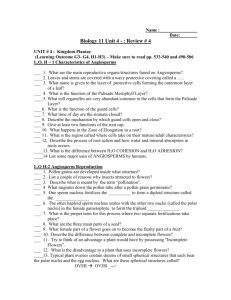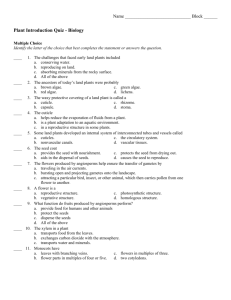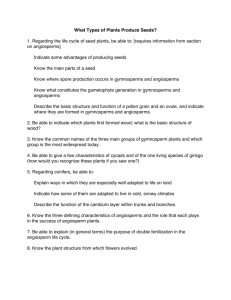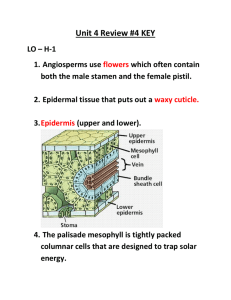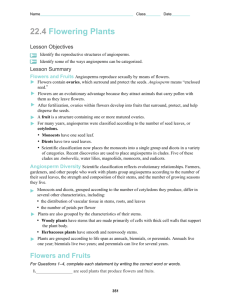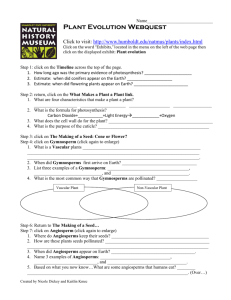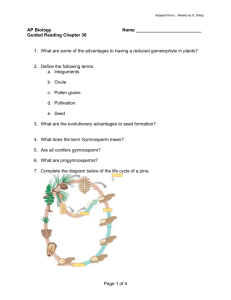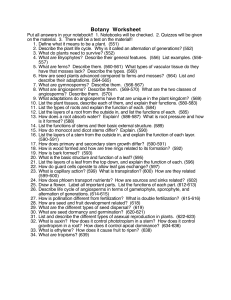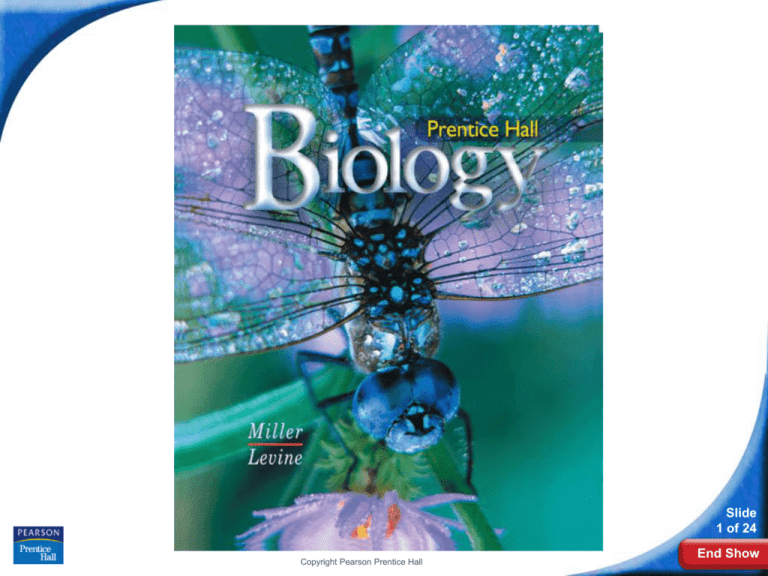
Biology
Slide
1 of 24
Copyright Pearson Prentice Hall
End Show
22–5 Angiosperms—Flowering
Plants
Slide
2 of 24
Copyright Pearson Prentice Hall
End Show
22–5 Angiosperms—Flowering
Plants
Flowers and Fruits
Flowers and Fruits
Angiosperms develop unique reproductive
organs known as flowers.
Slide
3 of 24
Copyright Pearson Prentice Hall
End Show
22–5 Angiosperms—Flowering
Plants
Flowers and Fruits
Flowers are an evolutionary advantage
because they attract animals, which then
transport pollen from flower to flower.
Flowers contain ovaries, which surround
and protect the seeds.
After pollination, the ovary develops into a fruit.
A fruit is a wall of tissue that surrounds a seed.
A fruit protects the seed and aids in its
dispersal.
Slide
4 of 24
Copyright Pearson Prentice Hall
End Show
22–5 Angiosperms—Flowering
Plants
Flower Anatomy
Slide
5 of 24
Copyright Pearson Prentice Hall
End Show
22–5 Angiosperms—Flowering
Plants
Diversity of Angiosperms
Diversity of Angiosperms
Angiosperms are categorized in many ways:
• monocots and dicots
• woody and herbaceous plants
• annuals, biennials, and perennials
An angiosperm can belong to more than one
category.
Slide
6 of 24
Copyright Pearson Prentice Hall
End Show
22–5 Angiosperms—Flowering
Plants
Diversity of Angiosperms
Monocots and dicots are named for the
number of seed leaves, or cotyledons, in the
plant embryo. Monocots have one seed leaf,
and dicots have two.
A cotyledon is the first leaf or the first pair of
leaves produced by the embryo of a seed plant.
Slide
7 of 24
Copyright Pearson Prentice Hall
End Show
22–5 Angiosperms—Flowering
Plants
Diversity of Angiosperms
Slide
8 of 24
Copyright Pearson Prentice Hall
End Show
22–5 Angiosperms—Flowering
Plants
Diversity of Angiosperms
Slide
9 of 24
Copyright Pearson Prentice Hall
End Show
22–5 Angiosperms—Flowering
Plants
Diversity of Angiosperms
Woody and Herbaceous Plants
Plant stems that are smooth and nonwoody are
characteristic of herbaceous plants.
Woody plants include trees, shrubs, and vines.
Slide
10 of 24
Copyright Pearson Prentice Hall
End Show
22–5 Angiosperms—Flowering
Plants
Diversity of Angiosperms
Annuals, Biennials, and Perennials
There are three categories of plant life
spans: annual, biennial, and perennial.
Plant life span is determined by genetic and
environmental factors.
Slide
11 of 24
Copyright Pearson Prentice Hall
End Show
22–5 Angiosperms—Flowering
Plants
Diversity of Angiosperms
Annuals are plants that complete a life cycle in one
growing season.
Slide
12 of 24
Copyright Pearson Prentice Hall
End Show
22–5 Angiosperms—Flowering
Plants
Biennials complete their life cycle in two years. In
the first year, they germinate and grow roots, short
stems, and sometimes leaves. In the second year,
they grow new stems and leaves, produce flowers
and seeds, and die.
Slide
13 of 24
Copyright Pearson Prentice Hall
End Show
22–5 Angiosperms—Flowering
Plants
Perennials live for more than two years.
Slide
14 of 24
Copyright Pearson Prentice Hall
End Show
22–5
Click to Launch:
Continue to:
- or -
Slide
15 of 24
End Show
Copyright Pearson Prentice Hall
22–5
One function of angiosperm fruit is to
a. distract animals from eating the rest of the
plant.
b. provide extra food for the seeds.
c. attract animals to eat the fruit and spread
seeds.
d. store food for use by the plant.
Slide
16 of 24
End Show
Copyright Pearson Prentice Hall
22–5
Flowers are specialized structures in
angiosperms that
a. have ovaries that surround and protect the
seeds.
b. attract animals to eat the flowers instead of
the plant.
c. are the site of asexual reproduction for the
plant.
d. make toxins to protect seeds developing
inside the flower.
Slide
17 of 24
End Show
Copyright Pearson Prentice Hall
22–5
Angiosperms that have one seed leaf are
classified as
a. biennials.
b. monocots.
c. dicots.
d. annuals.
Slide
18 of 24
End Show
Copyright Pearson Prentice Hall
22–5
Which of the following is a characteristic of
monocots?
a. branched veins
b. parallel veins
c. taproots
d. seed with two cotyledons
Slide
19 of 24
End Show
Copyright Pearson Prentice Hall
22–5
Flowering plants that live for more than two
years are called
a. biennials.
b. annuals.
c. perennials.
d. shrubs.
Slide
20 of 24
End Show
Copyright Pearson Prentice Hall
END OF SECTION



